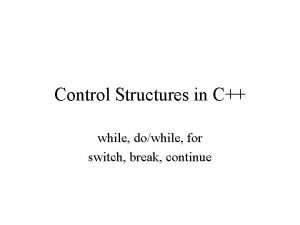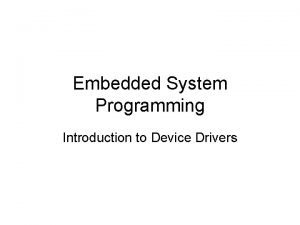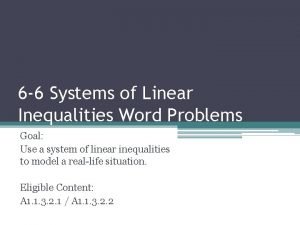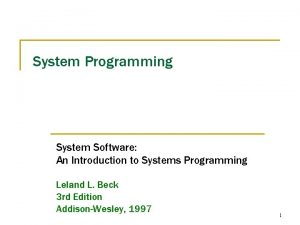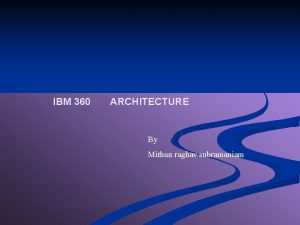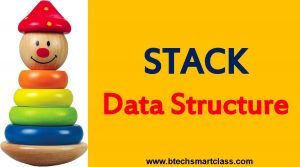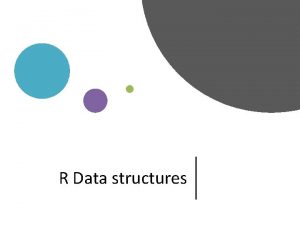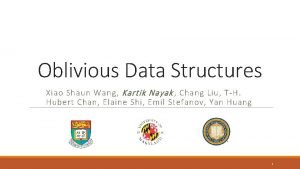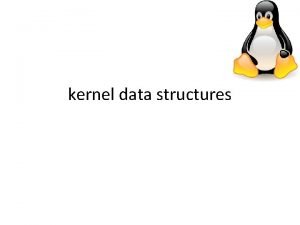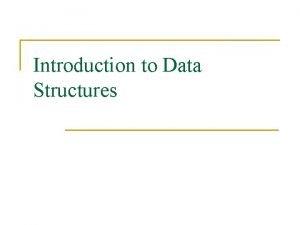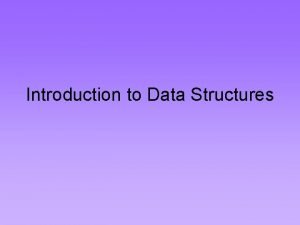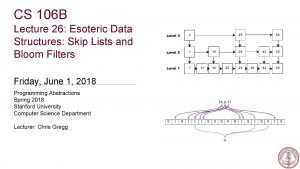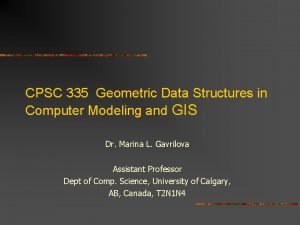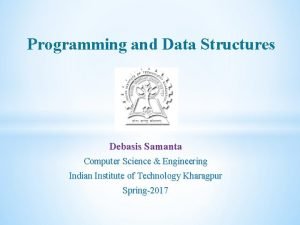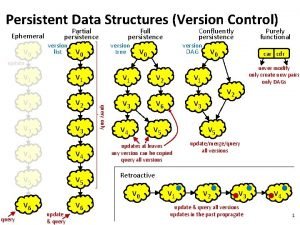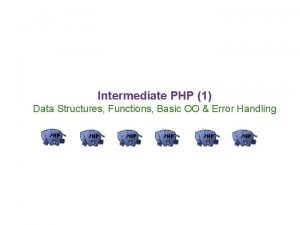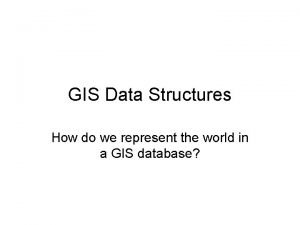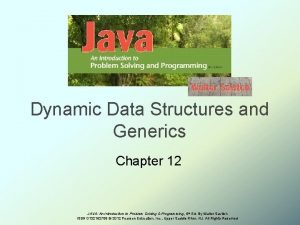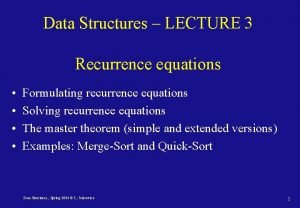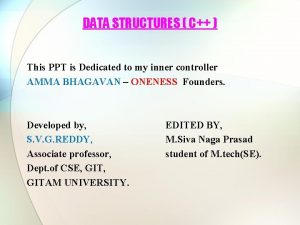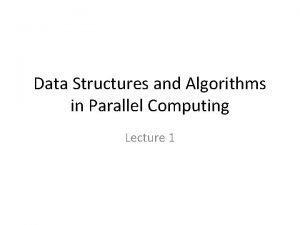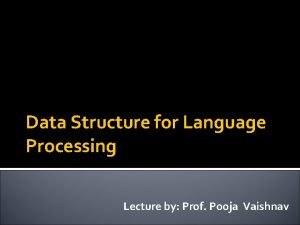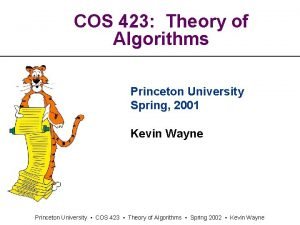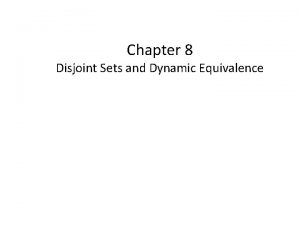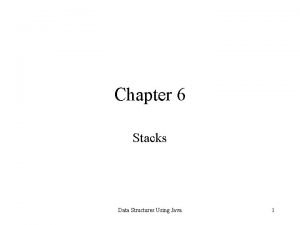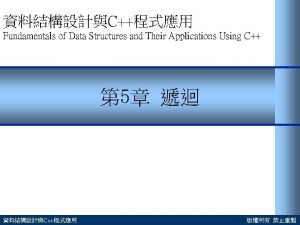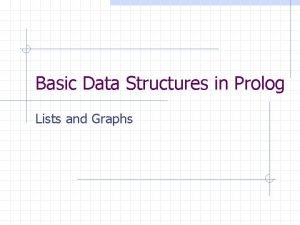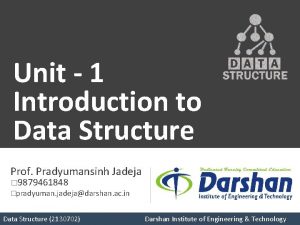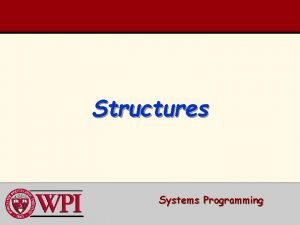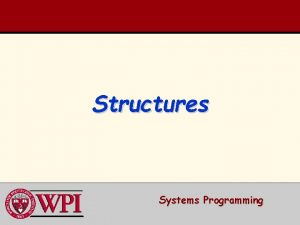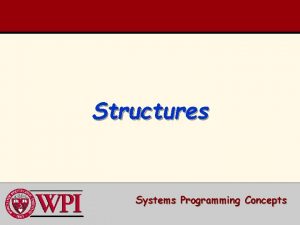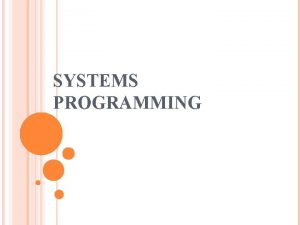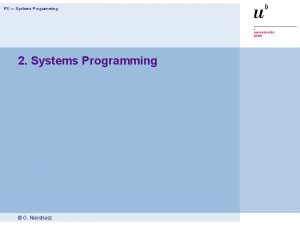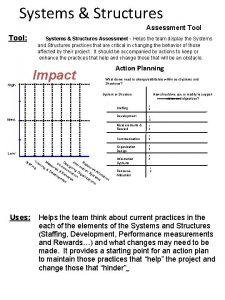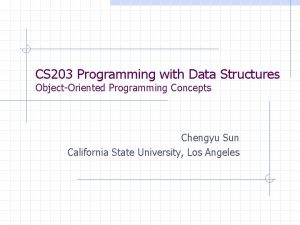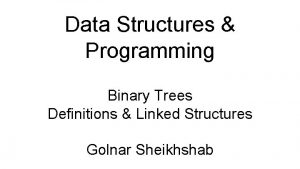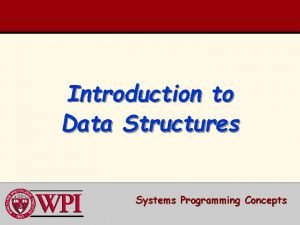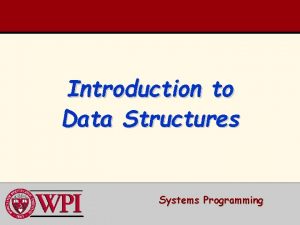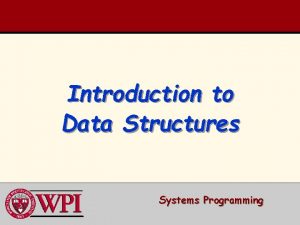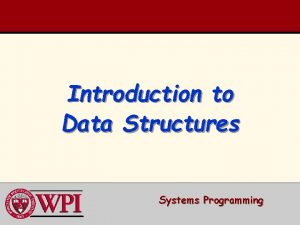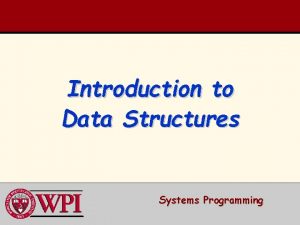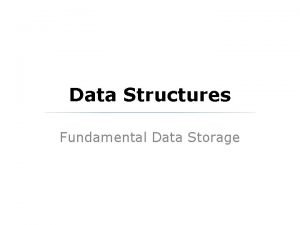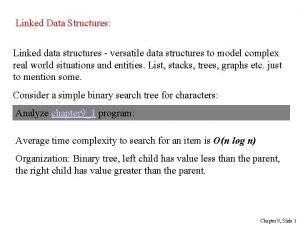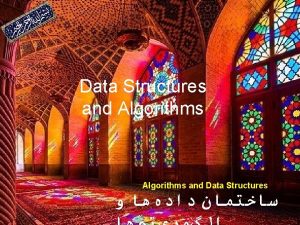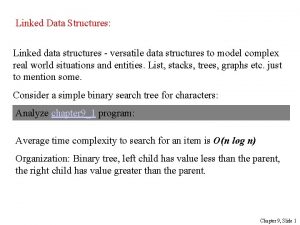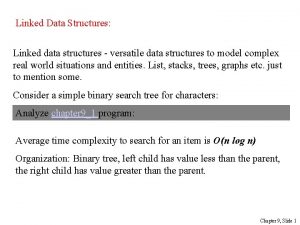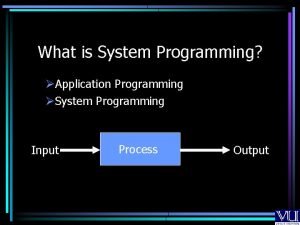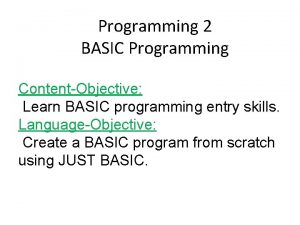Data Structures Systems Programming Data Structures Data Structures



















































![Example of Chain insert into a hash table with a BAD hash function [0] Example of Chain insert into a hash table with a BAD hash function [0]](https://slidetodoc.com/presentation_image_h/37504844093495f1221e90fb28de7421/image-52.jpg)


- Slides: 54

Data Structures Systems Programming: Data Structures

Data Structures § Queues § Trees – Queuing System Models – Queue Data Structures – A Queue Example – Binary Trees – Tree Traversals • Inorder, preorder, postorder § § § Stacks • A Stack Example Hashing Static Hashing Linear probing Chaining Systems Programming: Data Structures 2

Simple Queuing Model Arrivals Queue Server Systems Programming: Data Structures 3

Router Node 15 packet 17 Outgoing Link Router Buffer Server Systems Programming: Data Structures 4

Performance Metrics (General Definitions) § § Utilization : : the percentage of time a device is busy servicing a “customer”. Throughput : : the number of jobs processed by the “system” per unit time. Response time : : the time required to receive a response to a request (round-trip time). Delay : : the time to traverse from one end to the other in a system. Systems Programming: Data Structures 5

12. 6 Queues § Queues – Are very common structures in operating systems and computer networks. – The abstraction in system queues is of customers queued with one customer in service. – Customers are placed in the queue First-in, first-out (FIFO). – Customers are removed from the head of the queue structure. When modeling a server, the customer at the head of the queue is in service. – Customers are inserted at the back (or tail) of the queue. – Queues can model either finite of infinite buffer space. Systems Programming: Data Structures 6

Round Robin Queuing Systems Programming: Data Structures 7

12. 6 Queues § Queues – When modeling a finite buffer, when the buffer is full, an arriving customer is dropped (normally from the tail). This is known as a drop-tail queue. § Queue data structure operations: – Insert or enqueue – Remove or dequeue Systems Programming: Data Structures 8

Fig. 12 Queue graphical representation 2007 Pearson Ed -All rights reserved. Systems Programming: Data Structures 9

Fig. 12. 15 enqueue operation 2007 Pearson Ed -All rights reserved. Systems Programming: Data Structures 10

Fig. 12. 15 dequeue operation 2007 Pearson Ed -All rights reserved. Systems Programming: Data Structures 11

Fig 12. 13 Processing a Queue Each node in the queue contains a data element and a pointer to the next node Note that unlike linked lists and stacks, queues keep track of the tail node as well as the head 2007 Pearson Ed -All rights reserved. Systems Programming: Data Structures 12

Fig 12. 13 Processing a Queue 2007 Pearson Ed -All rights reserved. Systems Programming: Data Structures 13

Fig 12. 13 Processing a Queue 2007 Pearson Ed -All rights reserved. Systems Programming: Data Structures 14

Fig 12. 13 Processing a Queue To insert a node into the queue, memory must first be allocated for that node Queue nodes are always inserted at the tail, so there is no need to search for the node’s place If the queue is empty, the inserted node becomes the new head in addition to the new tail Inserted node becomes the new tail 2007 Pearson Ed -All rights reserved. Systems Programming: Data Structures 15

Fig 12. 13 Processing a Queue nodes are always removed from the head, so there is no need to search for the node’s place Second node becomes the new head If the removed node is the only node in the queue, it is the tail as well as the head of the queue, so tail. Ptr must be set to NULL Free the memory of the removed node 2007 Pearson Ed -All rights reserved. Systems Programming: Data Structures 16

Fig 12. 13 Processing a Queue 2007 Pearson Ed -All rights reserved. Systems Programming: Data Structures 17

Fig 12. 13 Processing a Queue 2007 Pearson Ed -All rights reserved. Systems Programming: Data Structures 18

Fig 12. 13 Processing a Queue 2007 Pearson Ed -All rights reserved. Systems Programming: Data Structures 19

12. 7 Trees § § Tree nodes contain two or more links. – All other data structures considered thus far have only contained one link. Binary trees – All nodes contain two links. • None, or both of which may be NULL – The root node is the first node in a tree. – Each link in the root node refers to a child – A node with no children is called a leaf node – A node can only be inserted as a leaf node in a binary search tree (i. e. , a tree without duplicates. ) 2007 Pearson Ed -All rights reserved. Systems Programming: Data Structures 20

Fig. 12. 17 Binary tree representation 2007 Pearson Ed -All rights reserved. Systems Programming: Data Structures 21

Common Programming Error 12. 8 § § Not setting to NULL the links in leaf nodes of a tree can lead to runtime errors. Remember, since tree traversals are normally recursive, this error can be ‘deeply embedded’. 2007 Pearson Ed -All rights reserved. Systems Programming: Data Structures 22

12. 7 Trees § Binary trees – The key value for nodes in the left subtree are less than the key value in the parent. – The key value for nodes in the right subtree are greater than the key value in the parent. – This data structure facilitates duplicate elimination! – Fast searches - for a balanced tree, maximum of log 2 n comparisons. 2007 Pearson Ed -All rights reserved. Systems Programming: Data Structures 23

Fig. 12. 18 Binary search tree 2007 Pearson Ed -All rights reserved. Systems Programming: Data Structures 24

The Three Standard Tree Traversals 1. Inorder traversal: § visit the nodes in ascending order by key value. 1. 1 Traverse the left subtree with an inorder traversal 1. 2 Visit the node (process the value in the node, i. e. , print the node value). 1. 3 Traverse the right subtree with an inorder traversal. Systems Programming: Data Structures 25

The Three Standard Tree Traversals 2. Preorder traversal: 2. 1 Visit the node (process the value in the node, i. e. , print the node value). 2. 2 Traverse the left subtree with a preorder traversal. 2. 3 Traverse the right subtree with a preorder traversal. Systems Programming: Data Structures 26

The Three Standard Tree Traversals 3. Postorder traversal: 3. 1 Traverse the left subtree with a postorder traversal. 3. 2 Traverse the right subtree with a postorder traversal. 3. 3 Visit the node (process the value in the node, i. e. , print the node value). Systems Programming: Data Structures 27

Tree Example Each node in the tree contains a data element and a pointer to the left and right child nodes data 2007 Pearson Ed -All rights reserved. Systems Programming: Data Structures 28

Tree Example 2007 Pearson Ed -All rights reserved. Systems Programming: Data Structures 29

Tree Example To insert a node into the tree, memory must first be allocated for that node If the inserted node’s data is less than the current node’s, the program will attempt to insert the node at the current node’s left child. 2007 Pearson Ed -All rights reserved. Systems Programming: Data Structures 30

Tree Example If the inserted node’s data is greater than the current node’s, the program will attempt to insert the node at the current node’s right child. The inorder traversal calls an inorder traversal on the node’s left child, then prints the node itself, then calls an inorder traversal on the right child. 2007 Pearson Ed -All rights reserved. Systems Programming: Data Structures 31

Tree Example The preorder traversal prints the node itself, then calls a preorder traversal on the node’s left child, then calls a preorder traversal on the right child. The postorder traversal calls an postorder traversal on the node’s left child, then calls an postorder traversal on the right child, then prints the node itself. 2007 Pearson Ed -All rights reserved. Systems Programming: Data Structures 32

12. 5 Stacks § Stack – New nodes are added and removed only at the top of the stack. – The classical analogy is a dishes stacker found in restaurants. – Last-in, first-out (LIFO) devices. – The bottom of stack is indicated by a link member to NULL. – Essentially, a constrained version of a linked list. – Stacks are important in computer languages because it is the data structure for calling and returning from function or subroutine calls. 2007 Pearson Ed -All rights reserved. Systems Programming: Data Structures 33

12. 5 Stacks § § § Stack operations push – Adds a new node to the top of the stack. pop – Removes a node from the top of the stack. – Stores the popped value. – Returns true if pop was successful. 2007 Pearson Ed -All rights reserved. Systems Programming: Data Structures 34

Fig. 12. 10 push operation 2007 Pearson Ed -All rights reserved. Systems Programming: Data Structures 35

Fig. 12. 10 pop operation 2007 Pearson Ed -All rights reserved. Systems Programming: Data Structures 36

A Stack Example Each node in the stack contains a data element and a pointer to the next node 2007 Pearson Ed -All rights reserved. Systems Programming: Data Structures 37

A Stack Example 2007 Pearson Ed -All rights reserved. Systems Programming: Data Structures 38

A Stack Example 2007 Pearson Ed -All rights reserved. To insert a node into the stack, memory must first be allocated for that node Systems Programming: Data Structures 39

A Stack Example Stack nodes are always inserted at the top, so there is no need to search for the node’s place Inserted node becomes the new top 2007 Pearson Ed -All rights reserved. Stack nodes are always removed from the top, so there is no need to search for the node’s place Second node becomes the new top Free the memory of the popped node Systems Programming: Data Structures 40

A Stack Example 2007 Pearson Ed -All rights reserved. Systems Programming: Data Structures 41

A Stack Example 2007 Pearson Ed -All rights reserved. Systems Programming: Data Structures 42

A Stack Example 2007 Pearson Ed -All rights reserved. Systems Programming: Data Structures 43

Hashing § § 1. 2. 3. 4. Two classic examples of the use of hashing are: {old example} Building a symbol table for a compiler, whereby a symbol table is similar to a dictionary, but with a set of name-attribute pairs. Standard operations on any symbol table are: Determine if the name is in the table. Retrieve the attributes of that name. Modify the attributes of that name. Insert a new name and its attributes in the table. Systems Programming: Data Structures 44

Tracking Flows in a Router Node 15 packet 17 Outgoing Link Router Buffer Server {new example} Systems Programming: Data Structures 45

Static Hashing § § In static hashing, identifiers (names) Are stored in a fixed size table called a hash table. A hash function f(x) is used to determine the location of an identifier x in the table. The hash table is stored into sequential memory locations that are partitioned into b buckets. Each bucket has s slots. Systems Programming: Data Structures 46

Hash Table Systems Programming: Data Structures 47

Hash Function § § § A good hash function is easy to compute and minimizes bucket collisions (i. e. , it should be unbiased). A good hash function hashes x such that x has an equal chance of hashing into any of the b buckets. Namely, the hash function should uniformly distribute the symbols into the b buckets. Examples of hash function are: mid-square, division f(x) = x % M and folding. Systems Programming: Data Structures 48

Hash Table Details We need to initialize table where all slots are empty. Void init_table (element ht[]) { int i; for (i =0; I < TABLE-SIZE; i++) ht[i]. key[0] = NULL; } § Systems Programming: Data Structures 49

Hash Table with Linear Probing There are four possibilities after hashing x into a table bucket: 1. The bucket contains x. {x is in the table already} 2. The bucket is empty. 3. The bucket contains a nonempty entry other than x. {a bucket collision}. Here we either examine next slot or the next bucket. 4. We have exhausted all table memory and have wrapped around to the ‘home bucket’. Systems Programming: Data Structures 50

Hash Table with Linear Probing § § § After running for awhile identifiers will tend to cluster and coalesce. Note, now the search time is likely to grow with each new addition to the symbol table. Result = Bad Performance. This is the motivation for implementing hash buckets using chaining ( each bucket is implemented as a linked list with a header node). Systems Programming: Data Structures 51
![Example of Chain insert into a hash table with a BAD hash function 0 Example of Chain insert into a hash table with a BAD hash function [0]](https://slidetodoc.com/presentation_image_h/37504844093495f1221e90fb28de7421/image-52.jpg)
Example of Chain insert into a hash table with a BAD hash function [0] -> add -> asp -> attitude [1] -> NULL [2] -> cat -> char -> cosine -> czar … [9] -> jack -> jumbo [10] -> king -> kinicki … [25] -> zac -> zebro -zits Systems Programming: Data Structures 52

More Advanced Hashing § § Dynamic Hashing Double Hashing Systems Programming: Data Structures 53

Summary of Data Structures § § Connected queuing computer systems with queuing data structures. Basic operations: enqueue and dequeue. Introduced tree terminology and structures – – Binary Trees Tree Traversals • Inorder, preorder, postorder § Stacks § A quick look at Hashing including: • A Stack Example – – Static Hashing Hash functions Linear probing Chaining (linked lists) Systems Programming: Data Structures 54
 Perbedaan linear programming dan integer programming
Perbedaan linear programming dan integer programming Greedy vs dynamic
Greedy vs dynamic Definition of system programming
Definition of system programming Linear vs integer programming
Linear vs integer programming Programing adalah
Programing adalah Setprecision in c++
Setprecision in c++ Real-time systems and programming languages
Real-time systems and programming languages Device driver programming in embedded systems
Device driver programming in embedded systems Systems of inequalities word problems worksheet
Systems of inequalities word problems worksheet System software: an introduction to systems programming
System software: an introduction to systems programming Real-time systems and programming languages
Real-time systems and programming languages Expert systems: principles and programming, fourth edition
Expert systems: principles and programming, fourth edition Homologous
Homologous Decision support systems and intelligent systems
Decision support systems and intelligent systems Engineering elegant systems: theory of systems engineering
Engineering elegant systems: theory of systems engineering Embedded systems vs cyber physical systems
Embedded systems vs cyber physical systems Elegant systems
Elegant systems Data formats of ibm 360
Data formats of ibm 360 Btechsmartclass.com
Btechsmartclass.com Data structures in r
Data structures in r Oblivious data structures
Oblivious data structures Linux kernel map data structure
Linux kernel map data structure Introduction to data structures
Introduction to data structures Introduction to data structures
Introduction to data structures Ajit diwan
Ajit diwan Esoteric data structures
Esoteric data structures Geometric data structures
Geometric data structures Kevin wayne princeton
Kevin wayne princeton Data structures and algorithms tutorial
Data structures and algorithms tutorial File based data structures in hadoop
File based data structures in hadoop Features of macro processor
Features of macro processor Advanced data structures in java
Advanced data structures in java Assembler algorithm and data structures
Assembler algorithm and data structures Debasis samanta data structure
Debasis samanta data structure Persistent vs ephemeral data structures
Persistent vs ephemeral data structures Php data structures
Php data structures Gis data structure types
Gis data structure types Information retrieval data structures and algorithms
Information retrieval data structures and algorithms Java dynamic data structures
Java dynamic data structures Recurrence data structures
Recurrence data structures Data structures in c ppt
Data structures in c ppt Data structures for parallel computing
Data structures for parallel computing Data structures and abstractions with java
Data structures and abstractions with java Data structures for language processing
Data structures for language processing Data structures and algorithms bits pilani
Data structures and algorithms bits pilani Cos 423
Cos 423 Dynamic equivalence problem in data structures
Dynamic equivalence problem in data structures Data structures using java
Data structures using java Fundamentals of data structures in c
Fundamentals of data structures in c Prolog data structures
Prolog data structures Data structure classification
Data structure classification Representation of polynomial using linked list
Representation of polynomial using linked list Adts, data structures, and problem solving with c++
Adts, data structures, and problem solving with c++ Dynamic data structures
Dynamic data structures Ajit diwan iit bombay
Ajit diwan iit bombay





